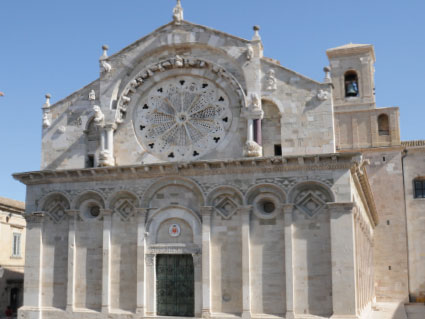




Perched at a height of 439 m asl, this ancient Apulian town overlooks the whole of the Capitanata area. Legend has it that Diomedes was the founder of Troia. During the Roman Empire, under Septimius Severus, it was a Roman colony called Augusta Apula Aecanorum. Saint Peter is believed to have visited the town in 44 B.C. In 1019 Basil Boiannes founded modern-day Troia, making it a Byzantine stronghold to challenge the Papacy and the Emperors of the West “by repopulating and militarising the Capitanata area”, bringing together the settlements of the old town (Terra dei Benedettini) and the new town (Terra dei Basiliani), once linked together by an ancient road that is today known as “Fra due Terre” (“between two lands”). In 1066, the town's inhabitants signed an alliance with the Normans, accepting their lordship and acclaiming Robert Guiscard as the “Most Holy Count of Troia”. Guiscard went on to build the Castello d’Occidente, or Castle of the West, and before his death Troia became the Norman capital, the main ducal city and then a royal residence. The Bishop Girando began the work for the building of the Cathedral “a fundamentis fere” (from the foundations up). The Magna Charta Libertatum, granted by Honorius II, brought independence to Troia, commemoratedy the bronze shutters crafted on one of the entrances to the Cathedral by Oderisio da Benevento (1127). The town was razed to the ground by Roger de Hauteville in 1133, then besieged by Frederick II of Swabia in 1230, who cursed the inhabitants of Troia for seven generations thereafter. Ruled over by the Angevins and later by the Aragonese, in 1503 the town saw the birth of Ettore De Pazzis, also known as Miale da Troia, one of the thirteen knights of the Challenge of Barletta. Following the wave of enthusiasm created by the Neapolitan Republic, on 8th February 1799 the “Tree of Liberty” was planted by Vincenzo Petruzzi and Luigi Giuliani, who were to be killed just a few days later. In 1856 Foggia became an independent Diocese, breaking away from the Diocese of Troia, and 1853 saw the birth of the statesman Antonio Salandra, who was to become a Minister and President of the Council of Ministers. Between 1940 and 1970, the population of Troia increased significantly, as a result of people moving there from the municipalities in the Daunian Pre-Apennines, rising to 11650 inhabitants in 1956. After 964 years, in 1986, the Diocese of Troia was suppressed and incorporated into that of Lucera.
Tourist Office
Piazza Giovanni XXIII
0881 970020
iattroia@viaggiareinpuglia.it
Pro Loco - Tourist Office
via Iamele n. 6
345.1533487
www.prolocotroia.it
info@prolocotroia.it
Town Police
0881 970071